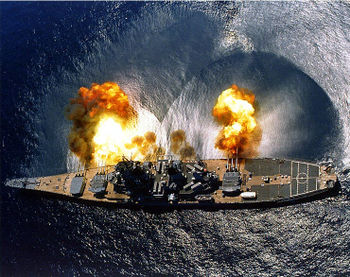Battleship: Difference between revisions
imported>Howard C. Berkowitz |
imported>Howard C. Berkowitz |
||
| Line 18: | Line 18: | ||
==References== | ==References== | ||
{{reflist}} | |||
Revision as of 11:21, 10 July 2009
The 20th century battleship, although obsolete as a naval weapon, evolved from the ship of the line, as a naval vessel intended to engage the most powerful ships of an opposing navy. Their main armament were multiple heavy cannon in turrets [1], and they were heavily armored and designed to survive punishment from other battleships.
Pre-dreadnoughts
Dreadnoughts
For a ship that only fought once, and that by ramming a German submarine, [[HMS Dreadnought (1905) made every other battleship in existence, or under construction, obsolete. ADM Jacky Fisher can fairly consider himself her father, insisting on the characteristics: guns of a single large caliber, in turrets; and high speed. Her large-caliber guns made irrelevant the intermediate-caliber guns of other battleships, as they could not get close enough to use them.
The Diversion of the Battlecruiser
A less successful creation of Fisher, the idea of the battlecruiser was a vessel with battleship-caliber guns, very high speed, and reduced armor, so it could kill whatever it could catch and run away from whatever could kill it. Unfortunately, those large guns were seductive to battleship admirals, and, rather than using it as a cruiser killer and commerce raider, succumbed to the temptation of adding battlecruiser firepower to a battleship engagement.
As Admiral Sir David Beatty, commanding the battlecruisers at the Battle of Jutland observed as the second of his battlecruisers exploded and sank, "there seems to be something wrong with our bloody ships today." This should not have been a mystery: the "something" was inadequate armor for the role in which they were placed.
Fast battleships
A few naval theorists suggest the exceptionally fast US Iowa-class battleships of World War II were really battlecruisers. Indeed, they were faster than the previous true South Dakota-class battleships and the planned Montana-class giants, but they had excellent armor. While their main guns were 16" rather than the 18.1" of the largest Japanese Yamato-class battleships, their speed, fire control, and probably better-penetrating ammunition might well have led them to defeat Yamato and Musashi, if the aviators had not sunk them first.
The last giants
References
- ↑ or barbettes in early designs
